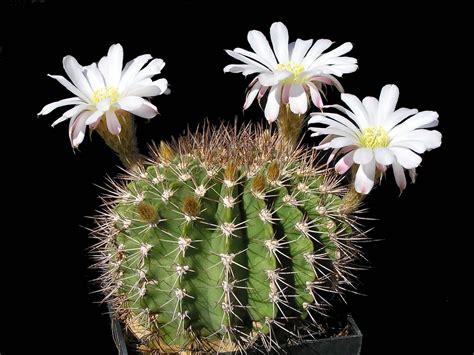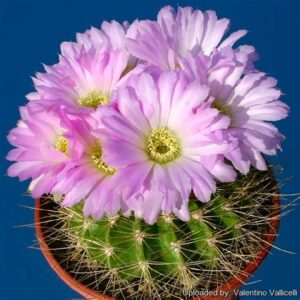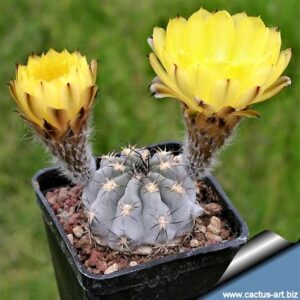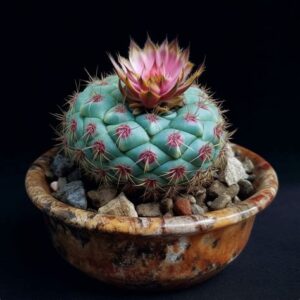Acanthocalycium klimpelianum, a name that rolls off the tongue with an air of mystery, encapsulates the essence of the enchanting world of cacti. This species, a member of the Cactaceae family, is not merely a botanical specimen; it is a tiny universe of resilience and beauty, thriving in a realm where few life forms can flourish. Its multifaceted charm extends beyond mere aesthetics, embodying the deep, intertwining strands of survival, adaptation, and allure.
The appearance of Acanthocalycium klimpelianum is nothing short of captivating. This cactus, native to the arid landscapes of Argentina, stands as a testament to nature’s artistry. With its spherical or cylindrical form, reaching heights of up to 10 centimeters and diameters of around 12 centimeters, it presents a charming compactness. The skin, enveloped in a tapestry of rich green to bluish-green hues, often exudes a slight gloss, reminiscent of precious jade glistening under the sun’s embrace.
The presence of tubercles, which serve as the cactus’s unique skin texture, creates distinctive patterns across its surface. These are capped with a spiky crown of areoles, each housing clusters of vibrant spines. The spines range from white to yellow or even reddish, creating an eclectic visual symphony that captures the eye. They can be formidable, but they also serve a practical purpose, protecting the plant from herbivores while also minimizing water loss in its harsh habitat.
In spring, Acanthocalycium klimpelianum reveals its pièce de résistance: the bloom. These vibrant flowers, often a striking pink or magenta, emerge from the areoles, unfurling with an exuberance that belies the cactus’s calm demeanor. The flowers, resembling delicate, whimsical crowns, can reach a diameter of up to 6 centimeters. They serve as a reminder of life’s vibrancy even in stark environments, drawing in pollinators like bees and hummingbirds, which contribute to the plant’s propagation.
While the physical allure of Acanthocalycium klimpelianum is undeniable, caring for this resilient plant requires knowledge, respect, and an understanding of its natural habitat. Cultivating this species successfully entails replicating its preferred arid environment, ensuring that it flourishes as it would in the wild.
The first aspect of care involves soil. A substrate that mimics the well-drained conditions of its native habitat is essential. A mixture of cactus potting soil, perlite, and gravel will provide the drainage required to prevent root rot, a common nemesis in the life of a cactus enthusiast. The ideal pH for the soil is slightly acidic to neutral, around 6.0 to 7.0, catering to its growth needs without overwhelming it with nutrients.
Watering Acanthocalycium klimpelianum is another crucial component of its care regime. The plant thrives on a delicate balance; overwatering can quickly lead to demise. During the growing season, typically from late spring to early autumn, the cactus should be watered thoroughly when the top inch of soil feels dry to the touch. However, in the dormant winter months, it is wise to scale back dramatically, offering just enough moisture to stave off desiccation. This cleverly instilled survival mechanism allows the plant to conserve resources in its native desert climate, where sporadic rainfall defines its existence.
Light is a critical factor in the successful cultivation of Acanthocalycium klimpelianum. This species craves the sun, thriving best in bright, indirect light. Placement near a south-facing window can yield optimal results, but care must be taken to shield it from the harshest midday rays, which can scorch its delicate epidermis. Artificial grow lights can be an excellent alternative in spaces lacking natural light, ensuring that the cactus receives the full spectrum it craves.
Temperature is also paramount; Acanthocalycium klimpelianum prefers temperatures between 20°C to 30°C (68°F to 86°F) during its active growth phase. However, it can withstand cooler conditions, dropping to around 5°C (41°F) in the dormancy phase. This resilience to temperature fluctuations mirrors the diverse conditions found in its native South American deserts, showcasing its adaptability.
Fertilization is an area where many enthusiasts often err. A light-handed approach is best, using a low-nitrogen fertilizer mixed at half-strength during the growing season. Over-fertilizing can result in leggy growth or even worse, a decline in overall health. Cactus plants thrive on minimalism, requiring only the essentials to flourish. It’s the art of doing less that often yields the most splendid results.
The habitat of Acanthocalycium klimpelianum paints a vivid picture of survival against all odds. Found primarily in the arid regions of northern Argentina, it has adapted to thrive in environments that would seem inhospitable to the untrained eye. Here, amidst rocky terrain and sun-baked soil, the cactus forms vital associations with its ecosystem. It shares its home with a plethora of wildlife, from pollinators to small mammals, each playing a unique role in the intricate web of life.
In this rugged landscape, water is a precious commodity. The cactus has evolved to absorb and store as much moisture as possible, utilizing its specialized tissues to survive prolonged dry spells. It relies on deep roots to seek out underground moisture, growing horizontally and vertically in a quest for sustenance. This remarkable adaptation speaks to the resilience of Acanthocalycium klimpelianum, acting as a beacon of life amid desolation.
The interplay between the cactus and its environment also underscores a larger ecological narrative. The symbiotic relationships forged in its habitat contribute to the survival of many species. By attracting pollinators with its vibrant blooms, it not only ensures its own reproduction but also sustains the creatures that rely on it for food. This mutualistic bond, akin to an intricate dance of life, illustrates how Acanthocalycium klimpelianum serves as both a participant and a contributor in its ecological community.
Acanthocalycium klimpelianum is not simply a plant; it is a symbol of resilience, adaptability, and the beauty of life in adversity. Its intoxicating appearance, coupled with the unique care it requires, makes it a captivating specimen for any cactus aficionado. Furthermore, understanding its habitat allows us to appreciate this exquisite species on a deeper level, fostering a connection that transcends the mere act of cultivation. By engaging with this remarkable cactus, one immerses themselves in a living tapestry that narrates the saga of survival, thriving against the odds—a testament to nature’s unmatched creativity and grace.
In summary, Acanthocalycium klimpelianum stands as an embodiment of the intricate relationships woven into the fabric of our natural world. By caring for this unique species, one not only nurtures a plant but also participates in the larger narrative of life. A commitment to understanding its needs ensures not only its survival but also a flourishing mutual relationship, enriching the experience of both the grower and the plant alike.





Leave a Comment